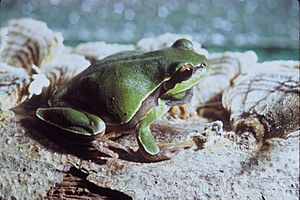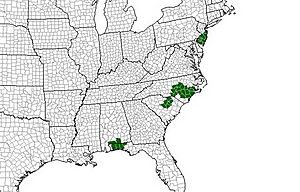Pine Barrens tree frog facts for kids
Quick facts for kids Pine Barrens tree frog |
|
|---|---|
 |
|
| Conservation status | |
| Scientific classification | |
| Synonyms | |
|
The Pine Barrens tree frog (Dryophytes andersonii) is a special kind of New World tree frog. It is becoming quite rare. This is mostly because its natural home is being lost.
Contents
What Does the Pine Barrens Tree Frog Look Like?
The Pine Barrens tree frog is a small frog. It is usually about 1 to 3 inches (25 to 76 mm) long. This makes it one of the smaller tree frog species. These frogs are mostly green. They have wide, dark stripes on their bodies.
You can often see orange-gold spots on the hidden parts of their legs. They also have big toe pads. These pads help them climb trees and other plants.
It can be tricky to tell this frog apart from the American green tree frog. However, the Pine Barrens tree frog has a special stripe. It has a lavender stripe with a white border on each side of its body. The American green tree frog only has a plain white stripe there.
Where Does the Pine Barrens Tree Frog Live?
Pine Barrens tree frogs usually live in brushy areas. You can often find them near peat bogs or shallow ponds. They like places covered with thick moss.
Adult frogs live on land. But they usually stay close to water sources. Unlike many frogs, they can live in water that is a bit acidic. They often lay their eggs in shallow, acidic ponds. The best water for their eggs has a pH level between 3.8 and 5.9.
Where Can You Find the Pine Barrens Tree Frog?
The Pine Barrens tree frog lives in three separate areas in the Southern United States. This is because there are not many suitable homes for them.
You can find them in the New Jersey Pine Barrens. They also live in the Sandhills of North and South Carolina. The third area is the Florida panhandle and southern Alabama.
A single Pine Barrens tree frog was once found in Georgia. However, there is no known group of them living there today. The Pine Barrens tree frog is the official state amphibian of North Carolina.
Is the Pine Barrens Tree Frog in Danger?
The Pine Barrens tree frog was once listed as endangered. This was by the US Fish and Wildlife Service between 1977 and 1983. More groups of these frogs were found in Florida after that.
The IUCN (International Union for Conservation of Nature) now lists it as "Near Threatened." This means it could become endangered in the future.
See also
 In Spanish: Rana arbórea del yermo de Pinos para niños
In Spanish: Rana arbórea del yermo de Pinos para niños



